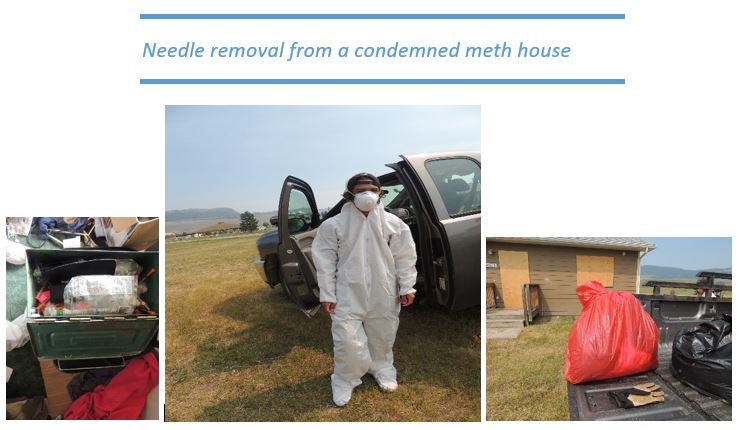A Brownfield site means real property, the expansion, redevelopment, or reuse of a property that may be complicated by the presence or potential presence of a hazardous substance, pollutant, or contaminants.* Cleaning up and reinvesting in these properties, cleans up the blight, takes development pressures off greenspaces, working lands, facilitates job growth, utilizes existing infrastructures, most of all it protects and improves the environment. The United States Environmental Protection Agency (EPA) established the Brownfields Tribal Response Program and has since then, grown into a principal nationwide plan of environmental restoration. In 2003, the Confederated Salish and Kootenai Tribes began a Tribal Brownfields Response Program funded by grant monies provided by the U.S. EPA.
On the Flathead Indian Reservation, there are Brownfields sites in existence. These sites can be almost anywhere and contain leaking underground storage tanks, abandoned or under used buildings, hazardous substance or polluted lands, open dumps, illegal dumps, mine scarred lands and methamphetamine contaminated properties.
CSKT Brownfields Tribal Response Program falls under the Brownfields and Land Revitalization in Region 8, which include 27 Tribal Nations, and the States of Montana, Colorado, North Dakota, South Dakota, Utah, and Wyoming. With in the United States there are 561 federally recognized tribes, each an independent, sovereign nation, responsible for setting standard, making environmental policy, and managing environmental programs for its people and communities. Many challenges are unique to individual tribes, but environmental issues and responses range from:
- developing basic administrative infrastructure to passing new ordinances and laws;
- controlling illegal open dumping to developing emergency response plans;
- abating and removing leaking underground storage tanks to addressing methamphetamine response and cleanup; and
- addressing air pollution to the clean up and reuse of contaminated land. **
The EPA provides financial assistance to states and tribes, which increases their capacity to meet the Brownfields cleanup and redevelopment challenges. Critical funding also helps to ensure that properties are cleaned up safely, according to state and tribal standards to protect Human Health and the Environment.
Administer and implement the TRP Four Elements.
- Timely Survey and Inventory of Brownfield Sites.
- Oversight and enforcement Authorities or Other mechanisms and Resources.
- Mechanisms and Resources to Provide Meaningful Opportunities for Public Participation.
- Mechanisms for Approval of a Cleanup Plan and Verification and Certification that Clean-up are Complete
The public can view all assessments, cleanups, and the Public Record by visiting the NRD Tribal Response Program office located office at 301 Main Street, Polson, MT 59860.
The Brownfield TRP Program has attended numerous training sessions on Brownfield, solid waste, and hazardous waste contaminants. The trainings assists the Tribal Response Program (TRP) manager and staff with keeping the reservation in its pristine environment and to ensure the protection of the Confederated Salish and Kootenai Tribes Natural Resources, its’ people, and future generation.The Brownfield Tribal Response Program ensures the protection of the Confederated Salish and Kootenai Tribes natural resources by inspecting the exterior boundaries of the reservation for illegal or abandoned sites that might comprise of solid and/or hazardous substance such as Illegal dumping that consists of waste materials that are unknown until investigated, these materials may have the probability to contaminate the natural resources of the reservation, and may cause severe health risks to the public and our water resources.
The Brownfield’s TRP Program conducts inspections through an approach that consist of; sample collection, laboratory and chemical analysis, field investigation, research, Photos’, observations, documenting, interviews, and inquiries. This assists the program to ensure that the safety of the tribes’ pristine natural resources is met.
If a community member has a complaint, there are several options available to file a complaint into the Tribal Response Program’s office:
- Come into the office and fill out a TRP Complaint Form, at 301 Main Street, Polson,
- Email the complaint to This email address is being protected from spambots. You need JavaScript enabled to view it.
- "Coming Soon" an app on your phone to send location of site found, file a complaint, with a record of contact.
To report a potential Brownfield site or to have an environmental site assessment done at a potential Brownfield site or to view information available in the public record(s) please provide the site location and contact information to:
MaryRose Morigeau, the Tribal Response Program Manager at This email address is being protected from spambots. You need JavaScript enabled to view it. , or P.O. Box 278, Pablo, MT 59855.
The Tribal Response Program Manager can also be reached by calling 406-883-2888 or (406) 675-2700, extension 7215.
The CSKT Natural Resources Department offices are located at 301 Main Street in Polson, Montana.
Business hours are from 7:00 a.m. to 5:30 p.m. Monday thru Thursday, exception of Holidays approved by the CSKT Tribal Council.
*The definition is found in Public Law 107-118 (H.R. 2869), the "Small Business Liability Relief and Brownfields Revitalization Act", signed into law January 11, 2002
**https://www.epa.gov/brownfields/state-and-tribal-brownfields-response-programs

